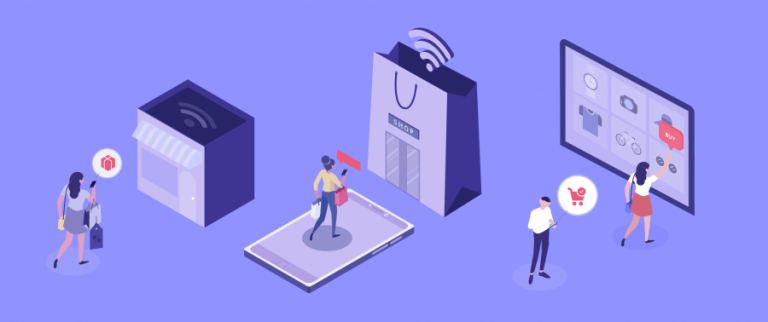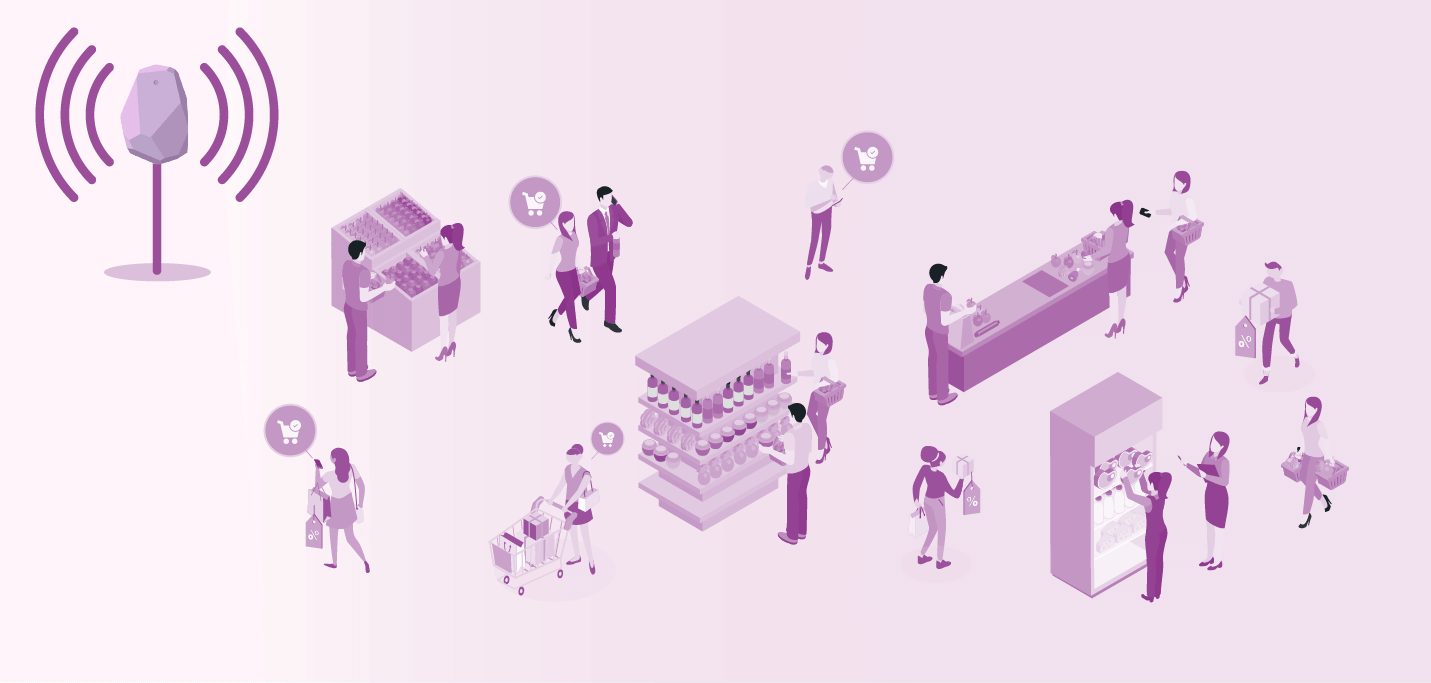Learn how you can Unlock Limitless Customer Lifetime Value with CleverTap’s All-in-One Customer Engagement Platform.

Beacons burst onto the scene in 2013 when Apple announced new iBeacon technology. At the time, the internet lit up with stories about how beacons would completely transform the shopping experience.
TechCrunch, The Verge, Forbes, and The Huffington Post all wrote articles on how this new technology could “change the world.” Wired wrote a piece covering the “entirely new technological frontier.”1 iBeacons opened up. Harvard Business Review hailed the devices as the solution to “the whole mobile-shopping puzzle.”2
The hype around beacons isn’t just buzz. The proven benefits are equally compelling: retailers can increase profits by nearly 9%, with an ROI of 175%.3
But five years later, retailers are still trying to crack the beacon marketing code. How can retail apps use beacon technology to improve the customer experience — instead of disrupting it? How can marketers use beacons in a way customers find cool, instead of creepy?
Keep reading to learn how beacons work, their benefits and challenges, and how 10 successful retail companies are using beacons to deliver a memorable brand experience.
Or simply jump to the infographic for a quick visual of how it works.
Beacon technology marketing is a type of location-based marketing. Beacons use Bluetooth technology to transmit information to nearby mobile devices. They offer a simple way for marketers to send timely, targeted messages to customers based on their physical location.
First launched in 2013, beacons have made a significant impact on the retail industry over the past 5 years. They account for 65% of all proximity marketing technology, with WiFi holding 20% and NFC sensors at 15%.4 Nearly 14.5 million beacons have been deployed globally as of Q1 2017, on track to hit a predicted 400 million units by 2020.5![]()
Image: ThinkWithGoogle
Beacons are small, battery-powered devices that can connect with mobile via Bluetooth low energy technology.
By placing beacons around a brick-and-mortar store, retailers can gather detailed information about customer movements to optimize the in-store experience and create highly personalized marketing campaigns. And because they’re Bluetooth-based, beacons can be deployed in areas with poor cell reception, like the interior of a store.![]()
Image: Digifractal

A Beginner’s Guide to Proximity Marketing
Beacons have been hailed as a way to bring the in-store experience into the mobile-first era.
1. Accuracy. Beacons provide more detailed location data than GPS or WiFi tracking. WiFi has a range of about 46 meters when used indoors, whereas beacons are accurate up to 450 meters.6
This allows brands to get a precise understanding of how shoppers navigate and interact with their stores, just as they understand exactly how they’re using the app or website. Brands can use this valuable data to understand what is and isn’t working with the in-store experience, improving everything from store layouts and displays to inventory and loss prevention.
2. Advanced personalization. Beacon advertising allows retailers to extend personalized offers and discounts to customers based on their exact location within the store. These timely offers tailored to each customer improve both conversions and the customer experience.
Say a customer pauses in front of a display of children’s swimwear and beach toys. Their phone lights up with a coupon for 20% off in-store purchases today only, or with a notification that sunscreen is just two aisles down.
3. Deeper customer insights. Data gathered from beacons goes beyond which areas of the store shoppers visit most. Retailers can analyze what day of the week and time of day shoppers are most likely to download and use certain in-store coupons. They can see which items are purchased together on the same shopping trip, and understand peak checkout times to help keep lines short and moving quickly.
4. Improved customer engagement. Average open rates for standard push notifications are 14%. Beacon-transmitted messages are opened 53% of the time.7 They’re immediately relevant to users, and they can influence customers during the crucial moment a purchase decision is being made.
5. Satisfied retailers. More than seven in 10 brands that have implemented beacons said they were able to better understand how consumers moved through the store and selected items to purchase because of them.8 Most retailers also believed beacons increased shopper engagement in stores, and helped them to create more relevant offers.
6. They’re effective. In a consumer study by beacon platform Swirl,* over 70% of shoppers who received beacon-triggered content and offers said it made them more likely to make a purchase during a store visit. More than 60% said they’d do more holiday shopping at brick-and-mortar stores that sent mobile offers while they shopped, and 61% said they’d visit a store more often if it offered beacon marketing campaigns.
1. Implementation and maintenance. Whether you’ve got one store or hundreds nationwide, installing, testing, and maintaining beacons is a major undertaking. Individual beacons are fairly inexpensive, typically around $20 each, depending on the size of the order. But many businesses don’t take into account the operational costs — for instance, someone has to manually map out and place each beacon, conduct ongoing tests, and replace faulty devices and spent batteries. All told, installing and managing beacons can cost around $300 per beacon per year.9
2. Device limitations. Shelley Bernstein writes about the realities of installing and using beacons at the Brooklyn Museum,10 including her frustrations with the physical device. In her experience, beacons are too heavy for adhesive, so they fall off walls. They lack serial numbers, making it difficult to tell them apart or identify a malfunctioning unit. And beacon signals can easily be obstructed by physical objects or people.
3. Customer Opt-Ins. In order for you to send messages to users via beacons, users will need to have:
That’s a lot of opt-ins.
One way retailers are getting around the app issue: partnering with major third-party apps that users are more likely to have installed on their phones: shopping and coupon apps, for example, or even Twitter.11
4. Customer behavior. Do you automatically pull out your phone as soon as you walk into a store? Neither do most people. Customers simply haven’t developed the habit of stopping to check their mobile device at each new display to see if there’s some new promo. They really only use their phone in brick and mortar stores to compare prices and read reviews.
Venkat Gopalan, an executive at Sephora, describes two issues his company found with beacons: most shoppers carry their phones in their purses or pockets, and they often walk so quickly from one department to another that it’s difficult to engage them with beacon-powered notifications.12
Because of these issues, a printed “Sale!” sign can be more likely to attract and engage customers than even a personalized, beacon-enabled push notification. As writer Barry Levine puts it, “Beacons are a high-resolution solution to a problem that doesn’t yet exist, for a behavior that consumers don’t yet have.”13
As with any new technology, beacons aren’t a perfect solution to the customer engagement problem. But they do offer some compelling benefits — benefits some of today’s biggest retailers are capitalizing on to drive purchases and brand loyalty. Here are 10 major brands with some of the best beacon marketing campaigns, using beacon advertising, and their results.
1. Target
Target uses beacons to help shoppers find their way through stores and locate specific products. Instead of simply showing a static map, or listing the aisle number where a product can be found, the Target app shows your real-time location on the store map, just like Google Maps. Click an item on your shopping list to see its location on the map, including the aisle number and any current promotions for that item.
2. Macy’s
During the 2015 Thanksgiving season, Macy’s used a beacon-powered mobile game to engage holiday shoppers. Customers received push notifications triggered by their proximity to beacons placed throughout 700 stores nationwide. These notifications encouraged them to participate in the “Black Friday Walk In and Win” game, with a chance to win $1 million in Macy’s gift codes and other prizes. This on-premise targeting successfully drove foot traffic, while proximity targeting at the Macy’s Thanksgiving Day Parade expanded their reach.
3. Nordstrom
Nordstrom provides the perfect example of using beacons to bridge the gap between online shopping and the in-store experience. Their beacon-enabled app notifies customers if an item in their mobile shopping bag is in stock as they pass a store with beacons installed. They’re also using beacons to show online options to in-store shoppers, make suggestions based on the customer’s interests, and expedite try-on and check-out.
4. CVS Pharmacies
Instead of sending customers coupons and promos, CVS uses beacons to deliver real-time customer service notifications, like a reminder to refill a prescription or to pick up one that is ready. 62% of CVS customers said the beacon-powered push notifications improved their in-store experience. That number jumped to 72% for those who received a pharmacy notification.
5. Walmart
The retail giant partnered with GE to place beacons discreetly inside LED light bulbs throughout the store and parking lots. The partnership not only allowed Walmart to send personalized push notifications and discounts to in-store customers, but also saved tens of thousands on energy costs per store every year.
6. Neiman Marcus
Rather than pushing coupons to customers, the high-end retailer took a different approach with beacons. It piloted beacons at three stores to promote in-store events like trunk shows, guest designers, and book signings happening on the same day a consumer is at the store. These informational push notifications saw CTRs on par with Neiman Marcus’ other marketing messages.*
7. Universal Display
This global mannequin company, which has supplied major retailers like Lord & Taylor, Saks, and Uniqlo, placed beacons inside their mannequins. These “smart mannequins” in window displays can send a signal to anyone within a 100-foot range of the store to increase foot traffic. And shoppers can instantly see the details of an outfit, or purchase any of its components right from their phones.
8. Levi’s Stadium Concessions
Home of the San Francisco 49ers, Levi’s Stadium features nearly 17,000 Bluetooth beacons that fans can use to find their seats, the nearest restrooms, and concessions. Paired with the Levi’s Stadium app, visitors can even have food delivered right to their seats. In seven months, the app got 183,000 downloads with a 30% adoption rate — and a $1.25 million increase in concession revenue.
9. Hillshire Farms
Hillshire Farms saw a 20x jump in purchase intent using beacon marketing solutions inside grocery stores. Shopping app users received a personalized message that highlighted the quality of Hillshire Farms’ products and prompted them to either add American Craft sausages to their in-app shopping lists or directly into their carts. The campaign resulted in more than 194,000 engagements and a 36% lift in brand awareness.
10. Alex and Ani
This jewellery retailer used beacons in all of its 40 stores to optimize store layouts and product placement, without sending a single promotion to customers. Instead, the brand used beacons to capture customer analytics, enhance store layouts, and educate consumers about its products. 30% of customers who viewed the digital beacon notifications visited the store.
Beacons are just one aspect of proximity marketing. No single technology or channel is going to be the holy grail of customer engagement.
Like any messaging channel, beacon-enabled notifications can’t just be about spamming users with coupons and discounts.
They’re a tool to provide a better customer experience — think messaging in-store staff and alerting them of the customer’s name, purchase history, needs, interests, etc. so that they can provide an improved, personalized customer experience. Or sending customers useful information about order status, guiding them around a store or to a more convenient checkout experience, or helping them save money.![]()
Embed this infographic into your own blog:

A Beginner’s Guide to Proximity Marketing